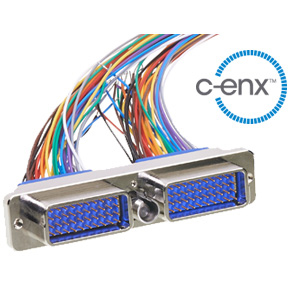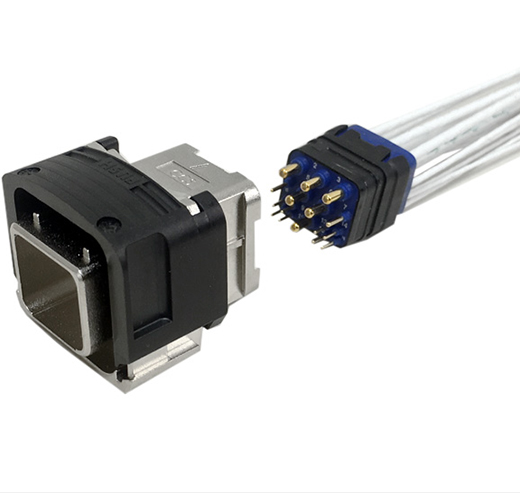
Modern Aerospace Industry Connectors
The aerospace industry is making sweeping changes to their connector requirements. The circular, metal connectors used to connect cables in planes for decades are in the early stages of being phased out for rectangular, composite connectors. These changes aim to increase modularity while reducing size and weight.
How did the Boeing 787 Change the Industry?
The Boeing 787 made its first commercial flight on December 15, 2009 and is no less a marvel today. Comprised of some 2.2 million parts, the aircraft seats up to 330 passengers, with a maximum range of 7,600 nautical miles and a top speed of Mach 0.90. More than 600 of the planes are in service around the world.
The 787 is a complex aircraft, with complicated electronic systems that are critical to everything that happens onboard. These electronics communicate through a maze of cable, notable in no small part for the hardware at each end. Each 787 carries thousands of rectangular cable connectors, and it’s not hyperbole to say the introduction of this technology in the 787 revolutionized the way connectors are designed for commercial aircraft.
The 787 was the first commercial aircraft to adopt rectangular connectors throughout the whole airplane. Others may have incorporated them in and around cockpit electronics, but the 787 ditched traditional round, metal connectors as the main connector in the pressurized environment. This sort of change is not insignificant. Changes in airplane parts and technologies are understandably slow. Once parts are qualified for use – a process that can take years and cost millions – they tend to be used for as long as the plane itself is in use. The aerospace industry may as well adopt, “If it ain’t broke, don’t fix it,” as its motto.
And yet, Boeing made sweeping changes to the connectors when it designed the 787 and now the industry is following suit. The circular, metal connectors used to connect cables in planes for decades are in the early stages of being phased out for the 787’s rectangular, composite connectors.
A change this significant happens for a reason – or in this case, three reasons:
- Replacing metal with composite reduces the weight of the connectors.
- The rectangular shape reduces the amount of wasted space between connectors.
- The modular design of the rectangular connectors offers production advantages borrowing from the automotive industry.
Commerical Aerospace Solutions
See the PossibilitiesModifying Connectors for Aircraft Weight Reduction
When Boeing was developing the 787, weight was an early issue. The first plane reportedly was 5,000 pounds heavier than specified, prompting designers to reevaluate many parts. The need to reduce weight at least in part drove the decision to deploy composite materials throughout the aircraft – making the 787 the first major commercial plane with a composite fuselage and composite wings, along with most other components of the frame.
The composite connectors were far less noteworthy when the plane debuted but no less revolutionary. The difference in weight between a single round metal connector and a single rectangular composite connector is barely noticeable, but the difference between thousands such connectors? That makes a big difference. And in an aircraft craving weight reduction, every ounce mattered.
Of course, weight reduction is important in all airplanes, not just the 787. Lighter planes burn less fuel and generate less CO2. Sparked by the introduction of the 787, one study concluded a fleet of composite planes could reduce carbon emissions by up to 15 percent compared to one using traditional materials. Conversely, lighter planes are capable of carrying more cargo, potentially reducing the number of flights required and costs to airlines and air transportation companies. These are among the many reasons the 787’s use of composites – and especially composite cable connectors – has become the model for the industry. This sort of transition takes time as new aircraft are introduced, but it’s not a stretch to say round metal connectors are an endangered species in the aerospace industry.
Optimizing Connectors for Space
Imagine a sheet of cookie dough. Now, think about using a round cookie cutter, going row by row, cutting out cookies for baking. When you’re finished, and the circles of dough are placed in the oven, all that dough between the circles is left. Now, imagine that same sheet of cookie dough, only this time imagine cutting the dough in squares – straight lines crisscrossing the dough to create a sheet full of square-shaped cookies. When those squares are placed in the oven, what’s left? Almost nothing. Not even enough waste for a snack while you wait for the cookies to bake.
This is the same principle behind the use of rectangular connectors. Traditionally, a plane would have panels of round cable input jacks accepting cables from all over the aircraft. The layout of those panels is similar to that first cookie sheet – lots of wasted space between and around the circular-shaped jacks. On these planes, space is at a premium. Designers search for additional space as meticulously as they seek to reduce extra weight. Rectangular connectors reshape those panels, allowing designers to squeeze more cables into the same space or reduce the size of the panel while still accommodating the same number of cable inputs. The space saved can be put to better use – squeezing in more equipment, cargo or passengers.
Multi-Platform Modularity
It’s not uncommon for automobile manufacturers to use the same parts in many different makes or models of car. A certain ball bearing or belt or a power window switch are a few examples. That sort of equipment standardization can streamline the supply chain and improve product quality. The same principles apply in airplane manufacturing, but that sort of platform flexibility doesn’t exist with round metal connectors. Circular connectors have an insert glued into the connector itself, and that insert can’t be changed. A specific connector is required for a specific application.
Rectangular connectors, like those in the Boeing 787, are different. They are made of multiple pieces, and those pieces can be mixed and matched to tailor the connector to a given application. To ensure safety, these connectors are keyed so only the right connector can go in a given dock. It’s a far more flexible, scalable approach to a part that can number well into the thousands on a single aircraft.
What’s Next for the Future of Connectors
The Bombardier C Series aircraft already has transitioned to rectangular connectors, and Gulfstream has used some rectangular connectors. More importantly, it is believed Boeing’s recently announced NMA (new mid-sized aircraft), the replacement for the 757, will use rectangular connectors and where Boeing goes, so goes the industry.
Looking ahead, fiber is the future of aircraft cable, and rectangular connectors are fiber-ready. Circular connectors generally are not. Make no mistake. The future of connectors is here, and it is rectangular.


